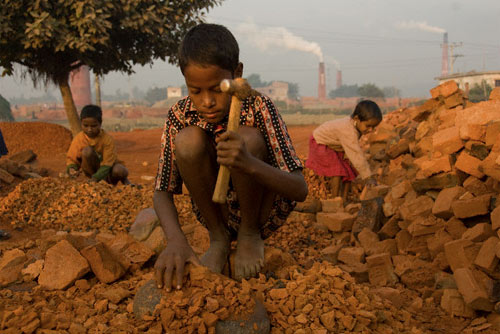By
Reuters
Reuters
Published
Sep 11, 2009
Sep 11, 2009
Child, forced labor behind many products
By
Reuters
Reuters
Published
Sep 11, 2009
Sep 11, 2009
NEW YORK (Reuters) - Children and forced laborers are mining gold, sewing clothing and harvesting cocoa around the world, and India is the source for the biggest number of products made by these workers, a U.S. government report said on Thursday 10 September.
 |
The Department of Labor for the first time released a list of goods produced by child or forced labor in foreign countries after Congress told it to compile one. The department looked at 122 products in 58 countries.
Under international labor standards, child labor is defined as work performed by someone under the age of 15, or under 18 where specific forms of work are deemed harmful, the report said. Forced labor is involuntary or done under threat.
In the new U.S. report, India was linked to the highest number of products made with child labor or forced labor including soccer balls and clothing, according to report.
Myanmar was noted the most often for forced labor for other products like rice, sugar cane and rubber.
"The purpose for doing this is to shine a spotlight so more activities can take place that target these problems," said Sandra Polaski, deputy undersecretary for International Affairs in the U.S. Department of Labor.
"In our country we think of these at 19th century problems but these are 21st century problems," Polaski said.
Child labor laws vary widely and the practice is banned in many countries. An international convention ratified by 154 countries requires them to set a minimum working age and to work toward eradicating child labor.
According to the U.S. report, Brazil, Bangladesh, China and the Philippines were also in the top six countries linked to individual products that use child or forced labor.
The International Labor Organization has found that 69 percent of child labor worldwide is in agriculture, the report said.
The most common agricultural goods produced by child or forced labor are cotton, sugarcane, tobacco, coffee, rice and cocoa. Both forms of labor for cotton production were found in countries including China, Pakistan and Uzbekistan. In India, this was the case for cottonseed.
The listing of specific goods and countries, however, does not mean that total production of specific products involve forced or child labor. Instead, the report said it indicates a "significant incidence" of these types of labor.
For cocoa, the key ingredient in chocolate, countries found using both forms of labor include the world's biggest producer Ivory Coast, as well as Nigeria, the report showed.
The most common mined goods included gold, where Peru and Burkina Faso use both child and forced labor, according to the report.
"Elimination of exploitive child labor or forced labor from a sector or a country requires intensive, sustained commitment by governments, employers, workers, and civil society organizations," the report said.
(By Marcy Nicholson. Editing by Cynthia Osterman)
© Thomson Reuters 2024 All rights reserved.

























